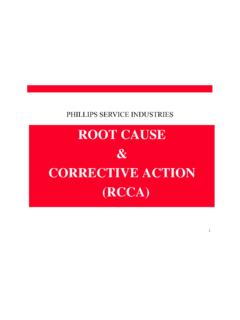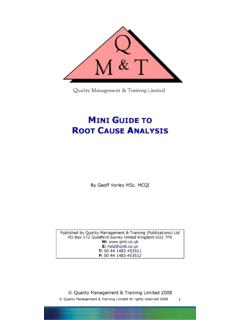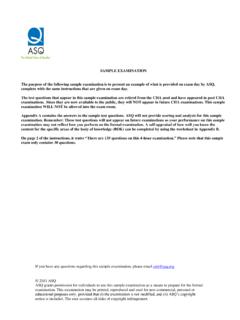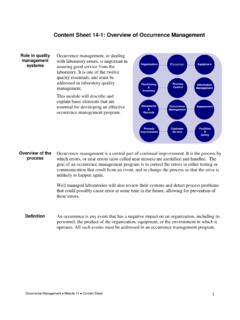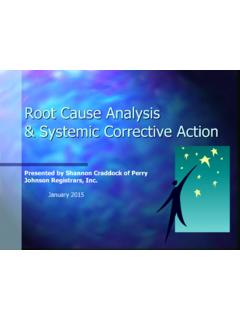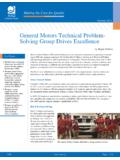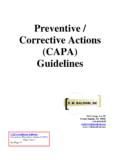Transcription of INTERNAL AUDIT REPORT: [PROCESS] - FED&T - MPG
1 Confidential: For INTERNAL Purposes Only INTERNAL AUDIT REPORT: [PROCESS] 2 SECTION TABLE OF CONTENTS PAGE 1 Introduction 3 Section A Executive Summary of Findings 4 1 Scope 4 2 Sources of Information 4 3 Standards for Professional Practice 4 4 Management Responsibilities 4 5 Summary of Findings 5 6 Opinion On INTERNAL Controls, Risk Management And Governance 6 7 Conclusion 6 8 Appreciation 6 Section B Detailed INTERNAL Findings 7 3 1. INTRODUCTION The INTERNAL AUDIT assignment was conducted in accordance with the approved INTERNAL AUDIT plan, covering the [Process] of the Department.
2 This report records the results of our INTERNAL AUDIT findings and recommendations looking at possible ways in which the controls and operations could be improved to overcome identified weaknesses in control and increase the adequacy, efficiency and effectiveness of controls based on the risk identified. The matters raised in this report are only those, which have come to our attention arising from our AUDIT that we believe they need to be brought to your attention. It is not a comprehensive record of all the matters arising and in particular we cannot be held responsible for reporting all risks and all INTERNAL control weaknesses.
3 The maintenance of effective control measures still remains the responsibility of management and not that of INTERNAL AUDIT . This report has been prepared solely for the use by the management of the Department of XXXXX. We do not accept responsibility to any third party to whom the contents may be disclosed or who at their own accord may decide to rely on it as the report has not been prepared for, and is not intended for, any other purpose. The report has been set out in two sections as follows: Section A - An executive summary documenting the scope of our work, sources of information, compliance with IIA standards and conclusion.
4 Section B - Detailed AUDIT findings 4 SECTION A - EXECUTIVE SUMMARY 1. SCOPE We have conducted the AUDIT assignment in terms of the approved INTERNAL AUDIT plan. The area covered by our members of staff during the fieldwork is [Process]. The time period covered by the AUDIT is from 1 April 2013 to 31 July 2013. AUDIT procedures performed are designed to evaluate the adequacy, efficiency and effectiveness of the Department s governance principles, risk management and control processes. 2. SOURCES OF INFORMATION Discussions were held with management and staff members.
5 AUDIT work was conducted on the basis of questionnaire, enquiry, observation, confirmation and verification of supporting documentation and identified processes. It is an inherent limitation that accounting and INTERNAL control systems cannot provide management with conclusive evidence that objectives are reached due to the following reasons: There is a potential human error due to carelessness distraction, mistakes of judgements and misunderstanding of instructions. The possibility that a person responsible for exercising an INTERNAL control could abuse that responsibility.
6 The possibility of circumventing of INTERNAL controls through the collusion of a member of management or an employee inside or an outside entity. The possibility that the procedures may become inadequate due to changes in conditions, and compliance with the procedures may deteriorate. 3. STANDARDS FOR PROFESSIONAL PRACTICE Paragraph of the Treasury Regulations states that the INTERNAL AUDIT must be conducted in accordance with the standards set by the Institute of INTERNAL Auditors.
7 The standards are principle focused, mandatory requirements consisting of statements of basic requirements for the professional practice of INTERNAL auditing and for evaluating the effectiveness of performance, which are internationally applicable at organisational and individual levels. We complied with the standards for the International Standards for the Professional Practice of INTERNAL Auditing, unless otherwise stated in this reports as issued by The Institute of INTERNAL Auditors, in the performance of our duties in respect of this focus area.
8 (Delete areas in red if not applicable) The following areas of non-conformance with the Code of Ethics or standards are highlighted: Reasons for non-conformance: 5 Impact of non-conformance on AUDIT engagement: 4. MANAGEMENT RESPONSIBILITIES IN TERMS OF GOVERNANCE, RISK AND CONTROLS Management is responsible for the establishment and maintenance of effective systems of governance to: Promote appropriate ethics and values within the department; Ensure effective organisational performance management and accountability; Communicate risk and control information to appropriate areas in the department.
9 And Coordinate the activities of and communication of information by EXCO, external and INTERNAL auditors and management. Management is further responsible for the establishment and maintenance of an effective system of INTERNAL control and risk management. The objectives of the system of INTERNAL control are, inter alia, to provide management with reasonable, but not absolute, assurance that: Objectives are achieved; Financial and operational information are reliable; Operations and programs are effective and efficient; Assets are safeguarded; Laws, regulations, policies, procedures and contracts are complied with; and Risks are identified, appropriate risk responses selected, communicated and managed.
10 The principal safeguard against fraud, misstatement and irregularities is an effective system of INTERNAL control. It must, however, be recognised that there are inherent limitations in any system of INTERNAL control including management override, human error and circumventions through collusion. The prevention and detection of fraud is therefore management s responsibility. Management representations made are considered to form part of our AUDIT evidence. Any management representations will be accepted on face value and in good faith.










